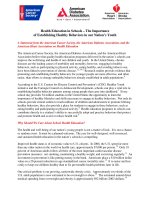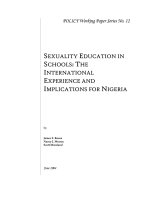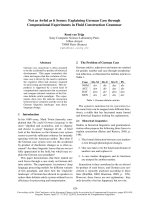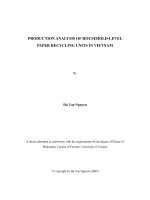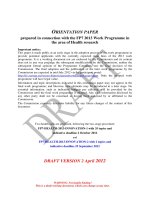Educating sustainability through paper recycling in schools
Bạn đang xem bản rút gọn của tài liệu. Xem và tải ngay bản đầy đủ của tài liệu tại đây (9.82 MB, 172 trang )
EDUCATING SUSTAINABILITY
THROUGH PAPER RECYCLING IN SCHOOLS
CHUA YING SHIUN
B.A. (INDUSTRIAL DESIGN) HONS.
A THESIS SUBMITTED
FOR THE DEGREE OF MASTER OF ARTS
IN INDUSTRIAL DESIGN
DEPARTMENT OF ARCHITECTURE
NATIONAL UNIVERSITY OF SINGAPORE
2008
ACKNOWLEDGEMENTS
First of all, I would like to thank the National University of Singapore (NUS) for
granting me a generous research scholarship that has helped me in my living and
studying expenses for the past two years of research.
I would also like to take this opportunity to express my immense gratitude to all of the
people who made this thesis possible:
I am most deeply indebted to my supervisor, Professor Teh Kem Jin for his excellent
guidance and support through my years as a student in NUS. I would like to thank
him especially for painstakingly reading and commenting on the numerous
preliminary drafts of this thesis, as well as his many precious suggestions for
improvement.
I am also thankful to my other tutors at the Department of Architecture in NUS, in
particular, Dr. Yen Ching Chiuan, Dr. Christian Boucharenc, Dr. Tukka Keinonen, Dr.
Tan Beng Kiang, Mr. Carlos Alberto Montana Hoyos and Ms Christiane English, for
their helpful advice, comments, critique, and also for their warm-hearted
encouragement.
On a final note, I recognize that I have been blessed with family members and
friends who have been most encouraging and supportive towards me during the
course of this research. And above all, I am eternally grateful to my Heavenly Father
for the marvelous love He has bestowed upon me. His grace has sustained and kept
me going throughout this journey.
ii
TABLE OF CONTENTS
Acknowledgements
………………………………………....................................
p. ii
Table of Contents
………………………………………....................................
p. iii
Summary
………………………………………....................................
p. v
List of Tables
………………………………………....................................
p. vi
List of Figures
………………………………………....................................
p. viiI
Section One - Introduction
……………………………………………………... p. 1
Chapter One - Solid Waste
……………………………………………………... p. 2
Chapter Two - Sustainability
……………………………………………………... p. 13
Chapter Three - Recycling
……………………………………………………... p. 25
Chapter Four - Paper
……………………………………………………... p. 32
Section Two - From Global To A Local Context
……………………………
p. 66
Chapter Five - Singapore
……………………………
p. 67
Chapter Six – Sustainability And Recycling In
……………………………
p. 85
Section Three – Design For Sustainability
…………………………….......
p. 94
Chapter Seven – Design Conceptualization
…………………………….......
p. 95
Chapter Eight – Feasibility Study
…………………………….......
p. 117
………………………………………………………………………...
p. 128
Bibliography ……………………………………………………………………......
p. 132
Singapore’s Schools
Conclusion
iii
Appendix A
………………………………………………………………………...
I
Appendix B
………………………………………………………………………...
II
Appendix C
………………………………………………………………………...
III
Appendix D
………………………………………………………………………...
IV
iv
SUMMARY
The thesis research starts with the study on the growth in paper usage and the issue
of sustainability. The study traces the evolution of men from early human settlements
to modern civilization to understand the problem of over-consumption and the
escalation of solid waste disposed globally. This raises the need for sustainability
and waste minimization, in particular, through the process of recycling.
This thesis also documents the relevant historical developments on the invention of
paper, as well as other inventions, such as the printing press, typewriter and
photocopying machine, which have aided in promoting the extensive consumption of
paper from the past to our present-day society.
The latter part of the study focuses on education as one of the most effective means
to promote sustainability. The study explores how schools as educators can have
better means of instilling in students the understanding and importance of
environmental protection, conservation and sustainability.
The thesis concludes with a test project that demonstrates the feasibility of
establishing a waste paper recycling system that could be incorporated as an
education resource for schools in Singapore.
.
v
LIST OF TABLES
Chapter Two - Sustainability
Table 2-1
………………………………………................................................
p. 21
The comparison of social, economic and environmental sustainability
Chapter Four - Paper
Table 4-1
………………………………………................................................
p. 61
Recyclable and non-recyclable paper
Table 4-2
………………………………………................................................
p. 64
The benefits of recycled paper production over new paper production
Table 4-3
………………………………………................................................
p. 65
Carbon dioxide emission from new paper production vs. recycled paper
production
Chapter Five - Sustainability
Table 5-1
………………………………………................................................
p. 82
Solid waste management statistics of Year 2005-2007
Chapter Six - Sustainability And Recycling In Singapore’s Schools
Table 6-1
………………………………………................................................
p. 85
Environmental education programs in Singapore national schools
Table 6-2
………………………………………................................................
p. 88
Students’ awareness to government environmental policies in Singapore
Table 6-3
………………………………………................................................
p. 89
Students’ response to products that can be recycled
vi
Chapter Seven – Design Conceptualization
Table 7-1
………………………………………................................................
p. 105
How to make a mold and a deckle
Table 7-2
………………………………………................................................
p. 110
How to make a simple press
Chapter Eight – Feasibility Study
Table 8-1
………………………………………................................................
p. 126
Samples of survey feedback
vii
LIST OF FIGURES
Chapter One – Solid Waste
Figure 1-1
………………………………………............................................
p. 2
Early humans in the hunter-gatherers lifestyle
Figure 1-2
………………………………………............................................
p. 3
The Neolithic Revolution – Early humans moved into agriculture
Figure 1-3
………………………………………............................................
p. 4
Agricultural is sometimes said to lead to civilization
Figure 1-4
………………………………………............................................
p. 6
Hunter-gatherers’ strong beliefs about sharing the spoils
Figure 1-5
………………………………………............................................
p. 8
The earliest form of recycling
Figure 1-6
………………………………………............................................
p. 9
The spread of the factory system during the Industrial Revolution
Chapter Two - Sustainability
Figure 2-1
………………………………………............................................
p. 13
The 1992 United Nations Conference on Environment and Development
Figure 2-2
………………………………………............................................
p. 15
Hans Carl von Carlowitz’s Sylvicultura Oeconomica
Figure 2-3
………………………………………............................................
p. 18
Dr. Gro Harlem Brundtland
Figure 2-4
………………………………………............................................
p. 20
The 2002 World Summit on Sustainable Development
viii
Figure 2-5
………………………………………............................................
p. 21
The three dimensions of sustainability
Chapter Three - Recycling
Figure 3-1
………………………………………............................................
p. 25
The main items of household refuse that get thrown away each week.
Figure 3-2
………………………………………............................................
p. 26
The hierarchy of waste management
Figure 3-3
………………………………………............................................
p. 27
Where our garbage goes to after disposal
Figure 3-4
………………………………………............................................
p. 29
How newspapers are recycled
Figure 3-5
………………………………………............................................
p. 31
The recycling symbol
Chapter Four - Paper
Figure 4-1
………………………………………............................................
p. 32
………………………………………............................................
p. 33
Papyrus
Figure 4-2
A drawing that illustrates how a sheet of papyrus is formed
Figure 4-3
………………………………………............................................
p. 34
Chinese paintings of papermaking
Figure 4-4
………………………………………............................................
p. 35
Moli Paperer de Capellades Museum
Figure 4-5
………………………………………............................................
p. 36
Pulp preparing
ix
Figure 4-6
………………………………………............................................
p. 36
………………………………………............................................
p. 37
Sheet forming
Figure 4-7
Sheet pressing
Figure 4-8
………………………………………............................................
p. 37
………………………………………............................................
p. 38
Sheet drying
Figure 4-9
The spread of paper
Figure 4-10
………………………………………............................................
p. 39
The Renaissance
Figure 4-11
………………………………………............................................
p. 40
Woodblock printing
Figure 4-12
………………………………………............................................
p. 41
Monks worked as scribes or book-copiers in the monasteries
Figure 4-13
………………………………………............................................
p. 42
Johann Gutenberg
Figure 4-14
………………………………………............................................
p. 43
Gutenberg’s idea
Figure 4-15
………………………………………............................................
p. 44
………………………………………............................................
p. 45
Movable type
Figure 4-16
The Gutenberg’s Bible
Figure 4-17
………………………………………............................................
p. 46
A drawing of a printing shop in Germany in the 1500s
Figure 4-18
………………………………………............................................
p. 49
The early typewriters
x
Figure 4-19
………………………………………............................................
p. 50
Haloid Xerox 914 office copier
Figure 4-20
………………………………………............................................
p. 52
Desktop publishing
Figure 4-21
………………………………………............................................
p. 53
Digital audio book
Figure 4-22
………………………………………............................................
p. 55
Global paper and paperbound consumption annually from 1970-2000
Figure 4-23
………………………………………............................................
p. 58
A paper recycling center
Figure 4-24
………………………………………............................................
p. 59
A typical paper recycling process
Figure 4-25
………………………………………............................................
p. 61
Open-loop recycling
Chapter Five - Singapore
Figure 5-1
………………………………………............................................
p. 67
Singapore is more than a red dot on the world map
Figure 5-2
………………………………………............................................
p. 68
Sir Stamford Raffles
Figure 5-3
………………………………………............................................
p. 69
Singapore as a fine trading port
Figure 5-4
………………………………………............................................
p. 70
The Japanese Occupation
Figure 5-5
………………………………………............................................
p. 72
Mr. Lee Kuan Yew
xi
Figure 5-6
………………………………………............................................
p.73
Modern Singapore
Figure 5-7
………………………………………............................................
p. 75
Sustainable Singapore
Figure 5-8
………………………………………............................................
p. 77
The six-fold increase in waste disposal in Singapore from Year 1970 to 2000
Figure 5-9
………………………………………............................................
p. 78
Singapore’s landfill
Figure 5-10
………………………………………............................................
p. 79
The Singapore Green Plan 2012
Figure 5-11
………………………………………............................................
p. 80
Recycling bins in Singapore
Figure 5-12
………………………………………............................................
p. 81
The national recycling program in Singapore
Figure 5-13
………………………………………............................................
p. 83
Students learning about environmental protection through environmental
programs in schools
Chapter Six - Sustainability And Recycling In Singapore’s Schools
Figure 6-1
………………………………………............................................
p. 90
Quantity of paper used in five primary schools from Year 2004 to 2006
Figure 6-2
………………………………………............................................
p. 90
Quantity of paper used in five secondary schools from Year 2004 to 2006
Figure 6-3
………………………………………............................................
p. 91
Quantity of paper used in five junior colleges from Year 2004 to 2006
xii
Figure 6-4
………………………………………............................................
p. 92
Recycling corner in school
Figure 6-5
………………………………………............................................
p. 93
Schools Recycling Outreach Program
Chapter Seven – Design Conceptualization
Figure 7-1
………………………………………............................................
p. 95
How paper is made and recycled in the industry
Figure 7-2
………………………………………............................................
p. 96
Preparing the ingredients
Figure 7-3
………………………………………............................................
p. 97
An ideal small papermaking workshop set up in the Barcelona School of Arts
& Crafts
Figure 7-4
………………………………………............................................
p. 98
A small papermaking corner
Figure 7-5
………………………………………............................................
p. 99
The Hollander beater
Figure 7-6
………………………………………............................................
p. 100
Preparing the pulp using a Hollander beater
Figure 7-7
………………………………………............................................
p. 101
Preparing the pulp using a kitchen blender
Figure 7-8
………………………………………............................................
p. 101
Preparing the pulp using a handheld blender
Figure 7-9
………………………………………............................................
p. 102
………………………………………............................................
p. 102
The vats
Figure 7-10
Preparing the vat
xiii
Figure 7-11
………………………………………............................................
p. 103
The mold and the deckle
Figure 7-12
………………………………………............................................
p. 104
Making large format white paper used for drawing or painting in fine arts
classes
Figure 7-13
………………………………………............................................
p. 107
………………………………………............................................
p. 108
Couching
Figure 7-14
A small iron press
Figure 7-15
………………………………………............................................
p. 109
A manufactured contemporary cast-iron press
Figure 7-16
………………………………………............................................
p. 112
………………………………………............................................
p. 113
………………………………………............................................
p. 113
Laying
Figure 7-17
Drying
Figure 7-18
Drying with the felt
Figure 7-19
………………………………………............................................
p. 114
Drying pressing using a press
Figure 7-20
………………………………………............................................
p. 114
Drying pressing using an iron
Figure 7-21
………………………………………............................................
p. 115
The system flow chart of paper recycling through papermaking by hand
Chapter Eight – Feasibility Study
Figure 8-1
………………………………………............................................
p. 117
xiv
The design process
Figure 8-2
………………………………………............................................
p. 118
Approval letter from the Ministry of Education
Figure 8-3
………………………………………............................................
p. 119
The Woodgrove Spirit
Figure 8-4
………………………………………............................................
p. 120
Woodgrove Secondary School received the Sustained Achievement Award
on 18 April 2008
Figure 8-5
………………………………………............................................
p. 121
Pilot project of the paper recycling system in Woodgrove Secondary School
Figure 8-6
………………………………………............................................
p. 122
A temporary and trial papermaking workshop set up for the pilot project
Figure 8-7
………………………………………............................................
p. 123
Students trying out the recycling of paper through papermaking
Figure 8-8
………………………………………............................................
p. 124
Woodgrove Secondary Schoo’s project display at the Clean & Greek Week
2006
Figure 8-9
………………………………………............................................
p. 125
Feasibility study survey questionnaire
Figure 8-10
………………………………………............................................
p. 126
Feasibility study results
xv
SECTION ONE – INTRODUCTION
“W
ASTE IS A HUMAN CONCEPT. In nature nothing is wasted. Everything
is part of a continuous cycle. Even the death of a creature provides
nutrients that will eventually be reincorporated in the chain of life. The idea of waste
springs from the perception of most material by-products of human activity as
useless.”1 The global waste crisis, the notion of sustainability and the need for
recycling are all hot discussion topics of today. These three topics are also three of
the key subjects that constitute to this research.
It is said that, “Research is finding out something you don’t know.”2 This first section
comprises of four introductory chapters. These chapters are a consolidation of the
background study done on the four key subjects of this thesis: solid waste,
sustainability, recycling and paper, so as to present the need and purpose for this
research.
1
2
Rusi. C. Cooper, ‘Introduction’, in id., War on waste: how to make millions from trash (Singapore:
Vocational Service Committee of the Rotary Club of Singapore, 1991), p. 1.
Estelle M. Phillips and D. S. Pugh, ‘Characteristics of research’, in id., How to get a Ph.D: a
handbook for students and their supervisors (2nd edn., Buckingham; Philadelphia: Open University
Press, 1994), p. 45.
1
CHAPTER ONE - SOLID WASTE
FIGURE 1-1 EARLY HUMANS IN THE HUNTER-GATHERERS LIFESTYLE
The hunter-gatherers move from area to area as each location is exhausted of
games and fruits. Usually the women gather roots, leaves and fruits, while the men
hunt.3
THE EVOLUTIONS IN HUMAN HISTORY AND THE RISE OF WASTE
According to archaeologists’ and historians’ findings and accounts, the early humans
lived a hunters and gatherers lifestyle.4 They lived by gathering wild edible plants,
such as nuts, acorns, grains, berries and fruits. Fishing and hunting of wild animals
3
4
Jacqueline Dineen, ‘Hunting’, in id., Hunting, harvesting and home (Surrey: Dragon’s World, 1995),
pp. 10-11.
Michael Woods and Mary B. Woods, ‘The Stone Age’, in id., Ancient agriculture: from foraging and
farming (Minneapolis, Minnesota: Lerner Publications, 2000), p. 13.
2
were also the other sources of food for them.5 They fundamentally lived on what they
were able to gather and hunt from the wild.6 The early humans generally do not stay
in one place for too long. After eating the food in one area, they would move on to
another place for more food.7
FIGURE
1-2
REVOLUTION
THE
–
EARLY
NEOLITHIC
HUMANS
MOVED INTO AGRICULTURE8
About fourteen thousand years ago at the end of the last Ice Age, a new lifestyle
emerged.9 Our ancient ancestors, who had previously lived by roaming around the
land in search for food, began to settle down in one place and built their permanent
homes.10 Over time, they discovered that it is possible to help plants grow in the wild
by tending and watering them. Similarly, they discovered that certain animals can be
5
6
7
8
9
10
Michael Woods and Mary B. Woods, ‘The Stone Age’, in id., Ancient agriculture: from foraging and
farming (Minneapolis, Minnesota: Lerner Publications, 2000), pp. 13-14.
Daniel Gilpin, ‘Hunting and gathering’, in id., Food and clothing (New York: Facts On File, 2004), p.
6.
Jacqueline Dineen, ‘Hunting’, in id., Hunting, harvesting and home (Surrey: Dragon’s World, 1995),
pp. 10-11.
Jacqueline Dineen, ‘Forced gifts and feasts’, in id., Hunting, harvesting and home (Surrey: Dragon’s
World, 1995), p. 75.
British Broadcasting Corporation, ‘The Neolithic Revolution - How farming changed the world’,
British Broadcasting Corporation (BBC) – h2g2 [website], published online 05 Mar. 2004,
< accessed 16 Jan. 2008.
Daniel Gilpin, ‘Farming takes hold’, in id., Food and clothing (New York: Facts On File, 2004), p. 1.
3
herded or kept in fenced areas.11 As a result, humans moved away from their former
hunting and gathering way of life, and moved into agriculture – the domestication of
plants and animals.12 Thus, agriculture took root and a new era was ushered in, the
Neolithic Era.13
FIGURE
1-3
SOMETIMES
AGRICULTURE
SAID
TO
LEAD
IS
TO
CIVILIZATION
Papyrus and other agricultural crops
were vital to the development of Egyptian
civilization.14
The domestication of plants and animals brought to mankind a more reliable source
of food. In fact, agriculture brought to mankind more than just food. For instance, the
fibers from plants and the skins from animal became useful materials in clothes
making. Domesticated animals like horses, cattle and camels became useful
transportation mediums as well.15 Dr. Michael Woods, an award-winning Washington,
11
12
13
14
15
Cathryn J. Long, ‘How agriculture began’, in id., The agriculture revolution (San Diego, California:
Lucent Books, 2004), p. 10.
Michael Woods and Mary B. Woods, ‘A changing society’, in id., Ancient agriculture: from foraging
and farming (Minneapolis, Minnesota: Lerner Publications, 2000), pp. 19-20.
British Broadcasting Corporation, ‘The Neolithic Revolution - How farming changed the world’,
British Broadcasting Corporation (BBC) – h2g2 [website], published online 05 Mar. 2004,
< accessed 16 Jan. 2008.
Alan K. Bowman, ‘Egypt, ancient’, Britannica Online Encyclopedia 2008,
< accessed 18 Jan. 2008.
Cathryn J. Long, op. cit.
4
D.C. based science and medical writer, together with his wife, described this in one
of their books: “Agriculture freed people from the need to spend every waking hour
searching for food. With the extra time, people could build villages and cities; create
literature, laws, and works of art; and invent new forms of technology to improve their
lives.”16
However, in the late 1970, Mark Cohen, an archaeologist, first suggested that
agriculture was born of desperation.17 Professor Jared Diamond from the University
of California, Los Angeles (UCLA) in one of his publications, described that, “As
population densities of hunter-gatherers slowly rose at the end of the ice ages, bands
had to choose between feeding more mouths by taking the first steps toward
agriculture, or else finding ways to limit growth. Some bands chose the former
solution, unable to anticipate the evils of farming, and seduced by the transient
abundance they enjoyed until population growth caught up with increased food
production. Such bands outbred and then drove off or killed the bands that chose to
remain hunter-gatherers, because a hundred malnourished farmers can still outfight
one healthy hunter. It's not that hunter-gatherers abandoned their life style, but that
those sensible enough not to abandon it were forced out of all areas except the ones
farmer didn't want.”18
16
17
18
Michael Woods and Mary B. Woods, ‘A changing society’, in id., Ancient agriculture: from foraging
and farming (Minneapolis, Minnesota: Lerner Publications, 2000), pp. 19-20.
The Economist Newspaper Limited, ‘Hunter-gatherers: noble or savage?’, The Economist [website],
published online 19 Dec. 2007, < />accessed 23 Jan. 2008.
Jared Diamond, ‘The worst mistake in the history of the human race’, Discover Magazine, May 1987,
pp. 64-66.
5
FIGURE 1-4 HUNTER-GATHERERS’ STRONG BELIEFS ABOUT SHARING THE
SPOILS
The men go out to hunt for animals, which will then be shared fairly between all the
people among the group.19
Professor Diamond added that, “Archaeologists studying the rise of farming have
reconstructed a crucial stage at which we made the worst mistake in human history.
Forced to choose between limiting population or trying to increase food production,
we chose the latter and ended up with starvation, warfare, and tyranny. Huntergatherers practiced the most successful and longest lasting lifestyle in human
history. In contrast, we're still struggling with the mess into which agriculture has
tumbled us, and it's unclear whether we can solve it.”20 Indeed, Professor Diamond
highlighted that agriculture, on a positive note, has unquestionably brought to us a
19
20
Jacqueline Dineen, ‘Dividing the spoils’, in id., Hunting, harvesting and home (Surrey: Dragon’s
World, 1995), p. 18.
Jared Diamond, ‘The worst mistake in the history of the human race’, Discover Magazine, May 1987,
pp. 64-66.
6
more abundant and variety of food, better tools and material goods, as well as the
longest and healthiest lives in history.21
However, agriculture has also on the other hand brought us health and waste
accumulation issues. As agriculture encourages people to gather together and form
settled societies, this also led to an easier spread of parasites and infectious
diseases. It is believed that epidemics are less likely to take hold in the earlier
population, as they were scattered in small bands and constantly shifting camps.22
From an ecological perspective as well, because the early hunter-gatherers do not
stay put in one place for a long time, the amount of waste they accumulated are
generally insignificant. However, as humans began to settle in permanent
communities with higher concentrations of waste-producing individual and activities,
the need for waste management became clear.23
Nonetheless, the waste situation during the agricultural era has yet to become a
concern for the environment as of today, as manufactured goods were still costly and
difficult to obtain up until the eighteenth century. Prudent consumption was the way
of life. Commodities were most often tended and mended to last as long as possible.
It is accounted that the discard materials were primarily organic discards, such as
food scraps, manure and human wastes, and they were most often gathered and
reused by farmers to fertilize their field. This practice in fact is marked as the earliest
form of recycling.24
21
22
23
24
Jared Diamond, ‘The worst mistake in the history of the human race’, Discover Magazine, May 1987,
pp. 64-66.
Ibid.
Joseph A. Ruiz, Jr., ‘The beginning’, in Herbert F. Lund (ed.), The McGraw-Hill recycling handbook
(2nd edn., New York: McGraw-Hill, 2001), pp. 1.1-1.2.
Heather Rogers, ‘Rubbish past’, in id., Gone tomorrow: the hidden life of garbage (New York: New
Press, 2005), pp. 29-30.
7
FIGURE 1-5 THE EARLIEST FORM OF
RECYCLING
A nineteenth century painting of a farmer
spreading manure to fertilize the soil and
increase his crop yield.25
Waste situation began to change dramatically as the Industrial Revolution set off in
Europe in the eighteenth century.26 Brenda Stalcup in her book explains that the
Industrial Revolution, in the most basic terms, “refers to the changes that take place
when a primarily agricultural economy begins to shift to the mechanized
manufacturing of goods on a large scale”.27 The advancement in technologies led to
greater production and distribution of goods.28 For instance, the introduction of
assembly line by Henry Ford, founder of Ford Motor Company,29 in 1913 ushered in
an age of full-scale mass production.30 And ever since then, goods began to be
manufactured in large quantities through the machinery production.31
25
26
27
28
29
30
31
Cathryn J. Long, ‘In this nineteenth-century painting, a farmer spreads manure to fertilizer the soil
and increase his crop yield’, in id., The agriculture revolution (San Diego, California: Lucent Books,
2004), p. 39.
Eric Pawson, ‘The causes of the Industrial Revolution in Britain’, in Brenda Stalcup (ed.), The
industrial revolution (San Diego, California: Greenhaven Press, 2002), p. 29.
Brenda Stalcup (ed.), ‘A brief history of the industrial revolution’, in id. (ed.), The industrial revolution
(San Diego, California: Greenhaven Press, 2002), p. 11.
Gray Cross and Rick Szotak, ‘From cottage to factory in Britain’, in Brenda Stalcup (ed.), The
industrial revolution (San Diego, California: Greenhaven Press, 2002), p. 64.
Asa Briggs (ed.), ‘Ford, Henry’, in id. (ed.), Who’s who in the twentieth century (Oxford: Oxford
University Press, 1999), p. 208.
Barbara Cady and Jean-Jacques Naudet, ‘Henry Ford’, in id., Icons of the twentieth century: 200
men and women who have made a difference (New York: The Overlook Press, 1998), p. 116.
Ray Batchelor, ‘Introduction’, in id., Henry Ford, mass production, Modernism and design
(Manchester; New York: Manchester University Press, 1994), p. 2.
8
FIGURE 1-6 THE SPREAD OF THE
FACTORY
SYSTEM
DURING
THE
INDUSTRIAL REVOLUTION
The assembly line system in Ford’s
Highland Park factory.32
American department-store entrepreneur, philanthropist and social reformer, Edward
A. Filene’s in his article, ‘Mass Production Makes A Better World’, states that, “mass
production can produce consumers by creating buying power”.33 Filene explains that,
“Because the production per man is high, it is possible to pay high wages.
Furthermore, when many articles are made by each worker under scientific mass
methods the difference between a high wages and a low wage is relatively small part
of the cost of each article. Then mass producers discover that the greatest total
profits are made from the smallest practical profit per unit, because only by selling
cheaply can the price be brought within the reach of the masses of consumers.”34
What Filene wrote is indeed true for Ford. It is said that even though Ford instituted
the industrial mass production, what really mattered to him was actually mass
consumption. Ford figured that if he could offer his factory workers with sufficient
32
33
34
David A. Hounshell, ‘The Ford Motor Company & the rise of mass production in America’, in id.,
From the American system to mass production 1800-1932: the development of manufactured
technology in the United States (Baltimore: Johns Hopkins University Press, 1984), p. 257.
Edward A. Filene, ‘Mass Production Makes a Better World’ (1929), in Josh Sakolsky (ed.), Critical
perspectives on the Industrial Revolution (New York: The Rosen Publishing Group, 2005), p. 143.
Ibid., pp. 143-144.
9
income and produced more cars in less time for less money, everyone would buy
them.35
Heather Rogers however describes in her book, ‘Gone Tomorrow: the hidden life of
garbage’ that, “The advent of what is often called Fordism – mass assembly-line
production coupled with mass standardized consumption and the mass psychology
that goes with both – created a tidal wave of trash, and it did so in three distinct
ways. First, the new Fordist economy used less recycled inputs from household
waste handled by independent junk traders; instead, scrap came from consortiums of
large materials handlers. Second, it built new forms of waste into both commodities
and the production process, in part because these cut labor time and externalized
cost, thereby boast profits. And third, the new economic regime created and
demanded unprecedented levels of consumption, the main by-product of which was
garbage.”36
The market however became increasingly saturated shortly within the first decade
after the World War II, as most of the consumers believed that they have already
gotten all that they needed. The manufacturers recognized that they needed a new
plan in order to sell more. Their answer was found in what is known today as, ‘Built-in
Obsolescence’, where the manufacturers intentionally make commodities wore out
faster than necessary.37 As a matter of fact, many products were even designed to
be thrown-away after one use.38 In Sally Lee’s book, ‘The Throwaway Society’, the
author described, “…billion disposable diapers a year to mountains of computer
35
36
37
38
Lee Iacocca, ‘Henry Ford’, in TIME/CBS News (ed.), People of the Century (New York: Simon &
Schuster, 1999), p. 37.
Heather Rogers, ‘The golden age of waste’, in id., Gone tomorrow: the hidden life of garbage (New
York: New Press, 2005), pp. 103-105.
Ibid.
Lester W. Milbrath, ‘Thrownaway mentality/society’, in Robert Paehlke (ed.), Conservation and
environmentalism: an encyclopedia (New York: Garland Publishing, 1995), p. 624.
10

